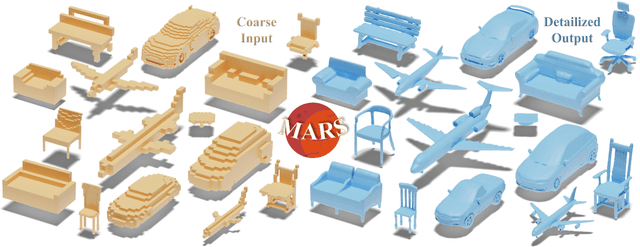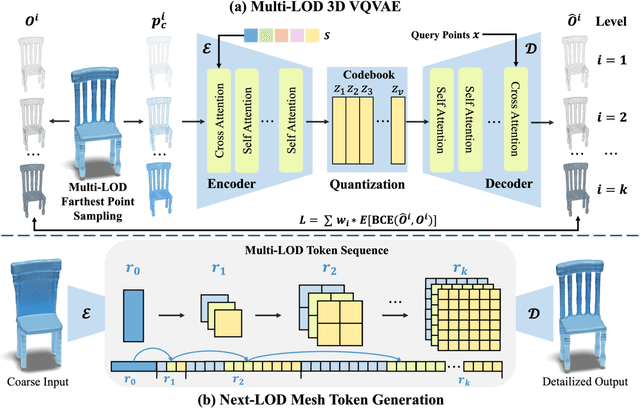Yichao Yan
Perceiving and Acting in First-Person: A Dataset and Benchmark for Egocentric Human-Object-Human Interactions
Aug 06, 2025Abstract:Learning action models from real-world human-centric interaction datasets is important towards building general-purpose intelligent assistants with efficiency. However, most existing datasets only offer specialist interaction category and ignore that AI assistants perceive and act based on first-person acquisition. We urge that both the generalist interaction knowledge and egocentric modality are indispensable. In this paper, we embed the manual-assisted task into a vision-language-action framework, where the assistant provides services to the instructor following egocentric vision and commands. With our hybrid RGB-MoCap system, pairs of assistants and instructors engage with multiple objects and the scene following GPT-generated scripts. Under this setting, we accomplish InterVLA, the first large-scale human-object-human interaction dataset with 11.4 hours and 1.2M frames of multimodal data, spanning 2 egocentric and 5 exocentric videos, accurate human/object motions and verbal commands. Furthermore, we establish novel benchmarks on egocentric human motion estimation, interaction synthesis, and interaction prediction with comprehensive analysis. We believe that our InterVLA testbed and the benchmarks will foster future works on building AI agents in the physical world.
MARS: Mesh AutoRegressive Model for 3D Shape Detailization
Feb 17, 2025



Abstract:State-of-the-art methods for mesh detailization predominantly utilize Generative Adversarial Networks (GANs) to generate detailed meshes from coarse ones. These methods typically learn a specific style code for each category or similar categories without enforcing geometry supervision across different Levels of Detail (LODs). Consequently, such methods often fail to generalize across a broader range of categories and cannot ensure shape consistency throughout the detailization process. In this paper, we introduce MARS, a novel approach for 3D shape detailization. Our method capitalizes on a novel multi-LOD, multi-category mesh representation to learn shape-consistent mesh representations in latent space across different LODs. We further propose a mesh autoregressive model capable of generating such latent representations through next-LOD token prediction. This approach significantly enhances the realism of the generated shapes. Extensive experiments conducted on the challenging 3D Shape Detailization benchmark demonstrate that our proposed MARS model achieves state-of-the-art performance, surpassing existing methods in both qualitative and quantitative assessments. Notably, the model's capability to generate fine-grained details while preserving the overall shape integrity is particularly commendable.
Disentangled Clothed Avatar Generation with Layered Representation
Jan 08, 2025



Abstract:Clothed avatar generation has wide applications in virtual and augmented reality, filmmaking, and more. Previous methods have achieved success in generating diverse digital avatars, however, generating avatars with disentangled components (\eg, body, hair, and clothes) has long been a challenge. In this paper, we propose LayerAvatar, the first feed-forward diffusion-based method for generating component-disentangled clothed avatars. To achieve this, we first propose a layered UV feature plane representation, where components are distributed in different layers of the Gaussian-based UV feature plane with corresponding semantic labels. This representation supports high-resolution and real-time rendering, as well as expressive animation including controllable gestures and facial expressions. Based on the well-designed representation, we train a single-stage diffusion model and introduce constrain terms to address the severe occlusion problem of the innermost human body layer. Extensive experiments demonstrate the impressive performances of our method in generating disentangled clothed avatars, and we further explore its applications in component transfer. The project page is available at: https://olivia23333.github.io/LayerAvatar/
Multimodal Latent Diffusion Model for Complex Sewing Pattern Generation
Dec 19, 2024



Abstract:Generating sewing patterns in garment design is receiving increasing attention due to its CG-friendly and flexible-editing nature. Previous sewing pattern generation methods have been able to produce exquisite clothing, but struggle to design complex garments with detailed control. To address these issues, we propose SewingLDM, a multi-modal generative model that generates sewing patterns controlled by text prompts, body shapes, and garment sketches. Initially, we extend the original vector of sewing patterns into a more comprehensive representation to cover more intricate details and then compress them into a compact latent space. To learn the sewing pattern distribution in the latent space, we design a two-step training strategy to inject the multi-modal conditions, \ie, body shapes, text prompts, and garment sketches, into a diffusion model, ensuring the generated garments are body-suited and detail-controlled. Comprehensive qualitative and quantitative experiments show the effectiveness of our proposed method, significantly surpassing previous approaches in terms of complex garment design and various body adaptability. Our project page: https://shengqiliu1.github.io/SewingLDM.
MotionBank: A Large-scale Video Motion Benchmark with Disentangled Rule-based Annotations
Oct 17, 2024



Abstract:In this paper, we tackle the problem of how to build and benchmark a large motion model (LMM). The ultimate goal of LMM is to serve as a foundation model for versatile motion-related tasks, e.g., human motion generation, with interpretability and generalizability. Though advanced, recent LMM-related works are still limited by small-scale motion data and costly text descriptions. Besides, previous motion benchmarks primarily focus on pure body movements, neglecting the ubiquitous motions in context, i.e., humans interacting with humans, objects, and scenes. To address these limitations, we consolidate large-scale video action datasets as knowledge banks to build MotionBank, which comprises 13 video action datasets, 1.24M motion sequences, and 132.9M frames of natural and diverse human motions. Different from laboratory-captured motions, in-the-wild human-centric videos contain abundant motions in context. To facilitate better motion text alignment, we also meticulously devise a motion caption generation algorithm to automatically produce rule-based, unbiased, and disentangled text descriptions via the kinematic characteristics for each motion. Extensive experiments show that our MotionBank is beneficial for general motion-related tasks of human motion generation, motion in-context generation, and motion understanding. Video motions together with the rule-based text annotations could serve as an efficient alternative for larger LMMs. Our dataset, codes, and benchmark will be publicly available at https://github.com/liangxuy/MotionBank.
MMHead: Towards Fine-grained Multi-modal 3D Facial Animation
Oct 10, 2024



Abstract:3D facial animation has attracted considerable attention due to its extensive applications in the multimedia field. Audio-driven 3D facial animation has been widely explored with promising results. However, multi-modal 3D facial animation, especially text-guided 3D facial animation is rarely explored due to the lack of multi-modal 3D facial animation dataset. To fill this gap, we first construct a large-scale multi-modal 3D facial animation dataset, MMHead, which consists of 49 hours of 3D facial motion sequences, speech audios, and rich hierarchical text annotations. Each text annotation contains abstract action and emotion descriptions, fine-grained facial and head movements (i.e., expression and head pose) descriptions, and three possible scenarios that may cause such emotion. Concretely, we integrate five public 2D portrait video datasets, and propose an automatic pipeline to 1) reconstruct 3D facial motion sequences from monocular videos; and 2) obtain hierarchical text annotations with the help of AU detection and ChatGPT. Based on the MMHead dataset, we establish benchmarks for two new tasks: text-induced 3D talking head animation and text-to-3D facial motion generation. Moreover, a simple but efficient VQ-VAE-based method named MM2Face is proposed to unify the multi-modal information and generate diverse and plausible 3D facial motions, which achieves competitive results on both benchmarks. Extensive experiments and comprehensive analysis demonstrate the significant potential of our dataset and benchmarks in promoting the development of multi-modal 3D facial animation.
Revealing Directions for Text-guided 3D Face Editing
Oct 07, 2024



Abstract:3D face editing is a significant task in multimedia, aimed at the manipulation of 3D face models across various control signals. The success of 3D-aware GAN provides expressive 3D models learned from 2D single-view images only, encouraging researchers to discover semantic editing directions in its latent space. However, previous methods face challenges in balancing quality, efficiency, and generalization. To solve the problem, we explore the possibility of introducing the strength of diffusion model into 3D-aware GANs. In this paper, we present Face Clan, a fast and text-general approach for generating and manipulating 3D faces based on arbitrary attribute descriptions. To achieve disentangled editing, we propose to diffuse on the latent space under a pair of opposite prompts to estimate the mask indicating the region of interest on latent codes. Based on the mask, we then apply denoising to the masked latent codes to reveal the editing direction. Our method offers a precisely controllable manipulation method, allowing users to intuitively customize regions of interest with the text description. Experiments demonstrate the effectiveness and generalization of our Face Clan for various pre-trained GANs. It offers an intuitive and wide application for text-guided face editing that contributes to the landscape of multimedia content creation.
PostEdit: Posterior Sampling for Efficient Zero-Shot Image Editing
Oct 07, 2024



Abstract:In the field of image editing, three core challenges persist: controllability, background preservation, and efficiency. Inversion-based methods rely on time-consuming optimization to preserve the features of the initial images, which results in low efficiency due to the requirement for extensive network inference. Conversely, inversion-free methods lack theoretical support for background similarity, as they circumvent the issue of maintaining initial features to achieve efficiency. As a consequence, none of these methods can achieve both high efficiency and background consistency. To tackle the challenges and the aforementioned disadvantages, we introduce PostEdit, a method that incorporates a posterior scheme to govern the diffusion sampling process. Specifically, a corresponding measurement term related to both the initial features and Langevin dynamics is introduced to optimize the estimated image generated by the given target prompt. Extensive experimental results indicate that the proposed PostEdit achieves state-of-the-art editing performance while accurately preserving unedited regions. Furthermore, the method is both inversion- and training-free, necessitating approximately 1.5 seconds and 18 GB of GPU memory to generate high-quality results.
AniSDF: Fused-Granularity Neural Surfaces with Anisotropic Encoding for High-Fidelity 3D Reconstruction
Oct 02, 2024Abstract:Neural radiance fields have recently revolutionized novel-view synthesis and achieved high-fidelity renderings. However, these methods sacrifice the geometry for the rendering quality, limiting their further applications including relighting and deformation. How to synthesize photo-realistic rendering while reconstructing accurate geometry remains an unsolved problem. In this work, we present AniSDF, a novel approach that learns fused-granularity neural surfaces with physics-based encoding for high-fidelity 3D reconstruction. Different from previous neural surfaces, our fused-granularity geometry structure balances the overall structures and fine geometric details, producing accurate geometry reconstruction. To disambiguate geometry from reflective appearance, we introduce blended radiance fields to model diffuse and specularity following the anisotropic spherical Gaussian encoding, a physics-based rendering pipeline. With these designs, AniSDF can reconstruct objects with complex structures and produce high-quality renderings. Furthermore, our method is a unified model that does not require complex hyperparameter tuning for specific objects. Extensive experiments demonstrate that our method boosts the quality of SDF-based methods by a great scale in both geometry reconstruction and novel-view synthesis.
HIMO: A New Benchmark for Full-Body Human Interacting with Multiple Objects
Jul 17, 2024



Abstract:Generating human-object interactions (HOIs) is critical with the tremendous advances of digital avatars. Existing datasets are typically limited to humans interacting with a single object while neglecting the ubiquitous manipulation of multiple objects. Thus, we propose HIMO, a large-scale MoCap dataset of full-body human interacting with multiple objects, containing 3.3K 4D HOI sequences and 4.08M 3D HOI frames. We also annotate HIMO with detailed textual descriptions and temporal segments, benchmarking two novel tasks of HOI synthesis conditioned on either the whole text prompt or the segmented text prompts as fine-grained timeline control. To address these novel tasks, we propose a dual-branch conditional diffusion model with a mutual interaction module for HOI synthesis. Besides, an auto-regressive generation pipeline is also designed to obtain smooth transitions between HOI segments. Experimental results demonstrate the generalization ability to unseen object geometries and temporal compositions.
 Add to Chrome
Add to Chrome Add to Firefox
Add to Firefox Add to Edge
Add to Edge